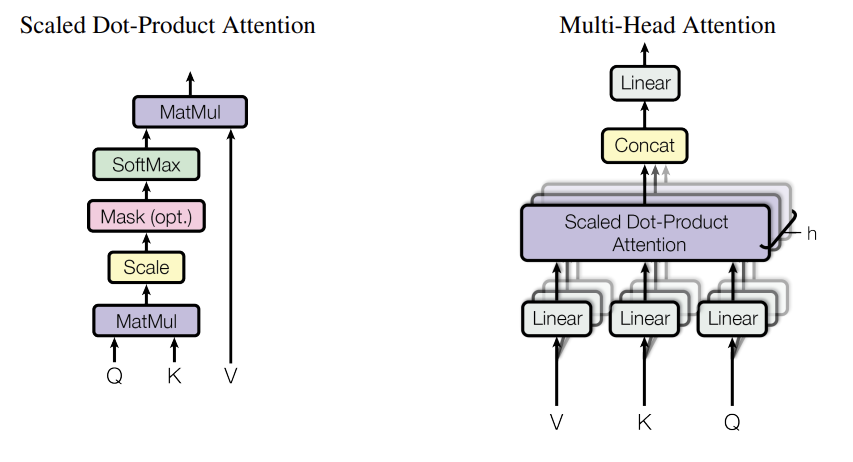怎么搞
在Encoder-Decoder模型中,Attention机制可以将编码器的输出和解码器的隐藏状态联系起来

我们需要计算的是解码器输出对于编码器输出的注意力(代码里的编码器输出指的是RNN的output,不是最后一层hidden)
对于编解码交叉注意力,我们需要将Context(Encoder输出)看成是K和V,将Decoder的输出看成是Q,再按照多头注意力的方法进行处理就可以了
代码
编解码Attention
class Attention(nn.Module):
def __init__(self):
super(Attention, self).__init__()
def forward(self, decoder_context, encoder_context):
# 计算decoder_context和encoder_context的点积,得到注意力分数
scores = torch.matmul(decoder_context, encoder_context.transpose(-2, -1))
# 归一化分数
attn_weights = nn.functional.softmax(scores, dim=-1)
# 将注意力权重乘以encoder_context,得到加权的上下文向量
context = torch.matmul(attn_weights, encoder_context)
return context, attn_weights多头交叉Attention
class MultiHeadAttention(nn.Module):
def __init__(self):
super(MultiHeadAttention, self).__init__()
#QKV线性变换
self.linear_q = torch.nn.Linear(128, 128)
self.linear_k = torch.nn.Linear(128, 128)
self.linear_v = torch.nn.Linear(128, 128)
# 最终拼接接结果的线性变换层
self.linear_out = torch.nn.Linear(128, 128)
def split_heads(self, tensor, num_heads):
batch_size, seq_len, feature_dim = tensor.size()
head_dim = feature_dim // num_heads
return tensor.view(batch_size, seq_len, num_heads, head_dim).transpose(1, 2)
def combine_heads(self, tensor, num_heads):
batch_size, num_heads, seq_len, head_dim = tensor.size()
feature_dim = num_heads * head_dim
return tensor.transpose(1, 2).contiguous().view(batch_size, seq_len, feature_dim)
def forward(self, decoder_context, encoder_context):
# 此处对decoder_context进行多头交叉注意力计算
# 定义头数,目前的隐藏层数量为128,此处设置头数为8
num_heads = 8
# 128 / 8 = 16
# 此处我们需要使得KV同源,为encoder_context
K = self.linear_q(encoder_context) # (batch_size, seq_len, Q_dim=128)
V = self.linear_k(encoder_context) # (batch_size, seq_len, Q_dim=128)
# Q则为decoder_context
Q = self.linear_v(decoder_context) # (batch_size, seq_len, Q_dim=128)
Q = self.split_heads(Q, num_heads) # (batch_size, num_heads=8, seq_len, head_dim=16)
K = self.split_heads(K, num_heads)
V = self.split_heads(V, num_heads)
# 计算 Q 和 K 的点积,作为相似度分数,也就是自注意力原始权重
raw_weights = torch.matmul(Q, K.transpose(-2, -1)) # (batch_size, num_heads, seq_len, seq_len)
# 自注意力原始权重进行缩放
scale_factor = K.size(-1) ** 0.5
scaled_weights = raw_weights / scale_factor # (batch_size, num_heads, seq_len, seq_len)
# 对缩放后的权重进行 softmax 归一化,得到注意力权重
attn_weights = F.softmax(scaled_weights, dim=-1) # (batch_size, num_heads, seq_len, seq_len)
# print(attn_weights.shape)
# print(V.shape)
# 将注意力权重应用于 V 向量,计算加权和,得到加权信息
attn_outputs = torch.matmul(attn_weights, V) # (batch_size, num_heads=8, seq_len, head_dim=16)
# 把头拼接起来
attn_outputs = self.combine_heads(attn_outputs, num_heads) # (batch_size, seq_len, feature_dim=128)
# 最终做个线性变换
context = self.linear_out(attn_outputs) # (batch_size, seq_len, output_dim=128)
# print(scores.shape,context.shape)
return context, attn_weights